► The finest sports cars of 2025 square up
► New 911 hybrid takes on Aston, AMG
► Destination: driving heaven
Three such directly comparable sports cars are rarely refreshed in such quick succession as this, but the new Porsche 911 Carrera GTS, Mercedes-AMG GT 63 and Aston Martin Vantage have all come rumbling up like vastly more appealing alternatives to double-decker buses.
We drove all three within six months of each other on their press launches last year, but this is the first time we’ve coaxed the set together.
The 911 GTS is newest on test and also most familiar, both in terms of its positioning as a Carrera S with a greatest-hits options package, and how it gently evolves the 992-generation 911 that first debuted for 2018.
But beneath the déjà-vu exterior lies a significant update for the powertrain: the T-Hybrid system that’s exclusive to the GTS, at least for now.
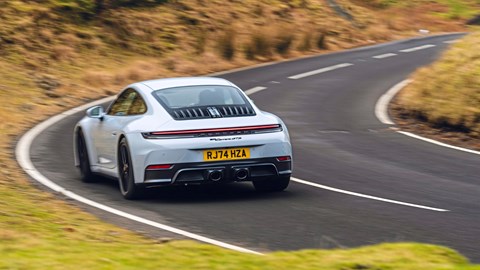
At its core lies a new single-turbo 3.6 flat-six engine that alone produces 478bhp, but a permanently excited synchronous motor in the dual-clutch gearbox adds 53bhp and 111lb ft of torque (there is no manual option with a T-Hybrid), and a second e-motor packaged in the turbo eliminates lag and chips in a further 15bhp. Both are fed by a pint-sized 1.9kWh 400-volt battery up front that sacrifices none of a Carrera’s 132 litres of luggage space.
The GTS can’t run about emissions-free, you can’t plug it in, and 26mpg is merely incremental, but power of 534bhp and 450lb ft bests its predecessor by 61bhp and 30lb ft and leaves the Carrera and Carrera S models (still with 3.0-litre twin turbo hand-me-downs) trailing more than ever before with 395bhp and 473bhp respectively. Even weight isn’t so bad, rising just 50kg to 1595kg (though making the 911’s plus-two rear seats optional helps).
Our rear-drive coupe costs from £132,600, a near £13k premium over the new Carrera S, and a circa £10k uplift over the previous 992.1 GTS – but both its RRP and as-tested price make the 911 the most affordable car in this test.
Nothing here drops you quite as satisfyingly low as the optional (£4622!) bucket seats in the 911, and while the bolsters hold you like a racecar, they’re also gorgeously comfortable. If only the backrests weren’t fixed so I could set my preferred reclined seating position.
The rest of the interior is classic Porsche – clean, understated lines, the rich aroma of leather, and tactile Alcantara for the small-diameter steering wheel. The latter’s thin rim slots so easily between thumb and forefinger I can’t decide whether to steer with it or play frisbee.
Black marks are reserved for mousetrap door pulls and a recessed infotainment screen that’s too much of a reach away but I feel a deep sense of connection to this car, even sitting still.
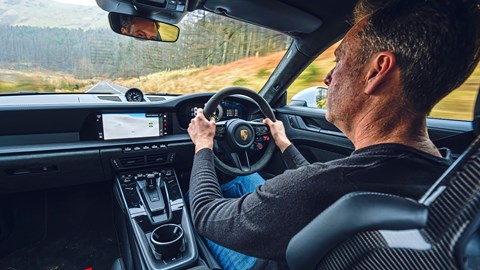
‘Cabin is excellent – best driving position, best steering wheel, best infotainment. Not a bad way to start,’ sums up James Dennison.
Fitted as standard with a sports exhaust, the new motor rouses with deep, mechanical ruminations and settles to a smooth, pulsing idle. Get moving and the only hint of electrification is the engine’s willingness to shut off approaching junctions and traffic lights – it can be a little overkeen to cut out but that’s easily disengaged by switching to Sport Plus mode with a twist of the dial on the steering wheel.
That also sharpens up the responses, but this engine always remains on high alert regardless. Squeeze the throttle in a high gear and it instantly hauls. Drop a cog, floor it and it winds out in one beautifully linear run to the redline, full of abundant power and instant energy. This is turbo midrange muscle with naturally aspirated response and it isn’t half strong.
‘Reponses are insane,’ concurs James. ‘In-gear or running it through the gears it squeezes every last bit of horsepower and will leave 99.9% of other road cars for dead.’

JD isn’t so keen on the darker sound texture, whereas I like this modern flat-six remix and its building howl, but we both find this a hugely impressive powertrain – one that makes a significant gain over even the 3.0-litre turbo six.
I actually keep forgetting I’m not driving a GT car (this car’s special front seats and lack of rears reinforce the illusion) and in that context, it does feel like Porsche is holding back to protect the GT3 – the PDK gearshifts are effective but could engage with more mechanical vigour; the redline feels like it calls time a little prematurely.
With 450lb ft ready to chip in immediately from just 1950rpm, the T-Hybrid system now gives the 911 chassis that’s so famed for its traction a proper workout, even with 10mm wider rear tyres – far more so than other modern Carreras, and the GT3 models that put less torque further out of reach.
It means adding all-wheel drive to this Carrera makes more sense than ever before, but the flipside is the rear-drive models are fantastically exploitable.
On this car’s standard-fit adaptive PASM adaptive dampers matched to 10mm lower springs, it is also gorgeously supple and stable almost no matter what. Back off abruptly at motorway speeds and it simply settles where you’d forgive a shimmy. When I seek out the toughest secondary pockmarks and primary undulations I know, the GTS just flows. The ride is remarkably good for any car, never mind one so sporting.
The rest of the package is defined by similar finesse. The steering has gorgeous weight, detailing and response, and the lack of kilos over the nose brings clarity the others can’t match, while the chunk of weight hung out behind the rear axle is way more stable and exploitable beyond the limit of grip than popular myth suggests. Standard rear-wheel steer is so seamlessly integrated into this melting pot that it never stands out.
Neither James nor I feel quite so confident in the front end as we do with the latest generation of GT products but everything from the powertrain to the handling fuzzes the boundary like never before.
‘Precise, predictable, agile,’ enthuses James. ‘Makes you want to learn how to drive it properly and really push it like a sports car.’
Mercedes-AMG first had a crack at building a 911 rival with GT back in 2014, but this visually comparable second-generation breaks significantly from that template, generally leaning more into ease of use – most notably with a transmission bolted to the back of the engine in place of the previous transaxle, allowing for optional plus-two rear seats and more luggage space. Less helpfully, weight distribution also flips from the original GT’s 47:53 front-to-rear to a nose-heavy 54:46. Remember the GT is also twinned with the new SL convertible, always a more comfort-focused tourer.
You can get your GT with a trick hybrid system, but both the 63 S E Performance’s 800bhp-plus output and £180k price put it in a rather different league to this 911.
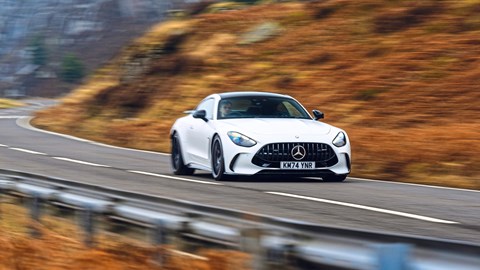
The GT63 is still much more expensive than the 911 at £164,905 in the UK’s best-selling Premium Plus trim but performance is comparable – AMG’s 4.0-litre twin-turbo V8 is re-worked here to produce 577bhp with 590lb ft (the latter a match for the Vantage’s related engine, a different planet to the 911’s 450lb ft).
Ultimate specification fast-tracks our test car to £175,905, but kit that’s extra on the 911 GTS is standard for the Merc, including Active Ride Control suspension and carbon-ceramic brakes, seats that are similarly trick to the 911’s and all-wheel drive. Adjusted for spec, the price differential isn’t quite as large as it initially appears. (The £9k of options Mercedes UK has added start and finish with sparkly white paint and extra driving-assistance kit that we won’t distract ourselves with here.)
The AMG is two tenths off the 911’s 3.0sec 0-62mph time and beats it by 1mph to a 196mph top end, but it’s a bigger car (by 175mm nose to tail) with more cylinders, more driven wheels, more power – all of which helps leave it trailing by 6mpg at 20mpg before it’s so much as left the WLTP lab, and – more importantly for our test purposes – makes its 1895kg some 300kg beefier.
But don’t think I’m teeing up the AMG as some kind of lardy, unfocussed grand tourer because it’s most definitely not.
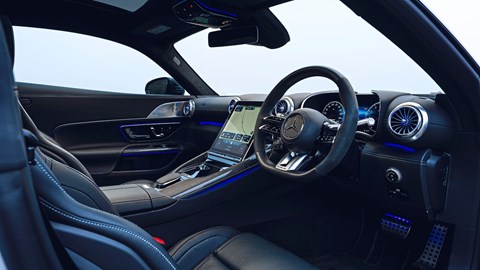
You sit down into standard-fit AMG Performance bucket seats trimmed in Nappa leather – a snug, purposeful position, if one not quite a low-set as the 911’s and with seat bases that are too firm.
Quality is top notch with lovely leather, gloss carbonfibre and chrome-effect detailing plus impressive MBUX infotainment served up on a reclined iPad-like portrait screen, but navigating driving modes via the touchscreen or little dials on the steering wheel is far less intuitive than it is in the 911 or Vantage.
In the dark it is also very flash in here with its mood lighting and whizzy screens, like sitting in a cocktail bar. The engine is similarly flamboyant, waking with a real crack of V8 thunder and a large side order of intimidation when I press the starter button.

On the go, the AMG does predictably feel a more cumbersome thing to hustle after driving the 911, not just its extra kerbweight but the way that weight is carried palpably higher in its chassis and much further forwards. The steering has more mass to gather up and get into the turn, and it feels a little doughy and synthetic after the clarity of the 911’s helm.
Rear-wheel steer is also more obviously present than it is in the 911, and together with all the other chassis trickery, the sense is of a nose-heavy car that’s been persuaded to do something it probably shouldn’t. It just doesn’t feel entirely natural in those first miles behind the wheel, yet it handles very ably nonetheless.
It takes a little time to dial into that, but I learn to drive more with my wrists, slow down my movements and carry more of that potential cornering speed – you can really hook the AMG into a turn with far more commitment than first impressions suggest. Only when I really carve at a mid-speed corner do I find understeer, and even then it’s manageable more than speed-sappingly frustrating.
The AMG definitely rides with something of a firm edge but the combined talents of interlinked dampers and active anti-roll suspension cope admirably with even very tricky surfaces, snuffing out little bumps, and plotting a course over roiling tarmac that gives me confidence to push on. 4Matic+ all-wheel drive also encourages me to climb all over the throttle without fear of unleashing a monster tank slapper. (Drift mode is available if you fancy one of those.)
JD agrees. ‘All wheel steer takes some getting used to, but when you combine it with the all-wheel drive, the forward-biased weight distribution and the direct steering it’s very effective,’ he says. ‘I’d wager that an average driver would go quicker on an unfamiliar road in the AMG – at least initially – than anything else here.’
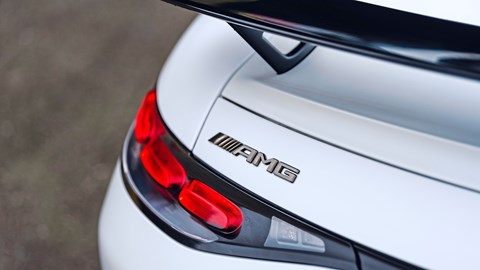
After the context of the Porsche and its instantaneous throttle, the V8 takes a little time to get into its stride but we’re talking a tiny fraction of lag here, not dozy pauses, and really this is properly boisterous performance with angry throttle response, a fierce turn of speed and a seriously rich midrange – the AMG lets rip with such carefree abandon I half expect to see bullets spraying from its exhaust tips. Shame the V8 is drowned out by whooshy turbo noises at peak revs but even then, it’s a welcome reminder than Affalterbach hasn’t gone all in on terrible four-cylinder hybrids.
Combined with a multi-clutch gearbox that whacks in the changes more decisively than anything else here (but can still be refined in gentle driving), there’s drama and excitement by the buckeload as I run up through the gears.
As an all-rounder there’s much to admire here, and there are ‘plus two’ seats and a boot that’s most generous on test by a margin, but there’s no getting away from the fact that the 911 is more incisive. Time to see how the Vantage compares.
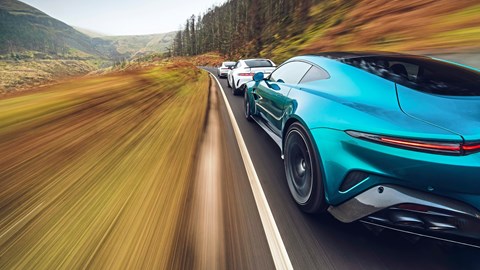
Every car here turns heads, but the Vantage is prettiest of all, slinking into view shorter, lower and wider than everything else – unfortunate traits for humans but rather more appealing when it comes to sports cars. It now costs £165,000, and Aston has bumped this one to £210,185 with treats including Bowers & Wilkins audio, 16-way adjustable seats and carbon ceramics that save 27kg in unsprung mass (total kerbweight is 1605kg dry, or around 200kg less than the AMG full of fluids).
Gone is the Voldemort grille and slightly soft lines of the first second-generation Vantage that debuted in 2018, replaced by a leaner, more purposeful look with crisp lines, a track widened 30mm with more fulsome hips inspired by the V12 Vantage that signed off the last generation and a rear bobbed like a Manx cat’s tail. Every panel bar the roof and doors is new and I can’t spot a bad angle on it.

But it’s the interior makeover that was more sorely needed, and Aston has delivered with a layout closer in concept to the restraint of the 911 than it is the new-money tech of the Merc.
So along with familiar hand-stitched Bridge of Weir leather (comfy seats too), there’s also fresh 10.25-inch touchscreen infotainment and a mix of gloss-black capacitive buttons and knurled rollers for key functions.
The infotainment can lag, some of our testers found the digital dash too bright at night and the typeface is either too small or too plain or both, but no one disagrees it’s a massive step forwards and much more befitting of a luxury brand.

Much has changed under the skin too, most notable being the 4.0-litre twin-turbocharged V8 which now jumps 30 per cent to 656bhp, and 15 cent to 590lb ft torque – the Merc matches the Aston’s torque, but neither it nor the Porsche comes close to its power.
Aston claims 7% more torsional rigidity for the bonded aluminium platform, plus there are new Michelin Pilot Sport 5S tyres, Bilstein DTX dampers and new Active Vehicle Dynamics chassis control software that plays conductor over the hardware, helping everything from the e-diff to the dampers and new nine-stage traction control sing from the same song sheet.
Press the central starter that pulses invitingly red and the Aston’s V8 roars to life and settles to a fast-paced heartbeat of an idle, already sounding keen to get moving. Slot Drive and the torque convertor gets it rolling instantly too, again adding more energy. Just moving round a car park, the Aston has an effortless glide.
So much shove with comparatively little weight over the driven axle means the Aston is relatively tardy to 62mph at, well, 3.5 seconds, but nothing here can match its 202mph top end and, besides, it’s the bit in the middle that’s most important, and which the Aston absolutely romps
Raw figures say the Aston has 79bhp more power than its German cousin with the same torque, but it /feels/ stronger on torque. The midrange is just so rich in this car and acceleration so urgent it just never feels remotely close to running out of puff, and yet I’m pretty sure the mapping feels more linear than the AMG, which means it always feels manageable and predictable to mete out.
‘Not quite sure how AMG has allowed this to happen given it’s their engine, but the Aston does AMG V8 better than the AMG. It sounds better, revs better and I think it’s slightly more progressive,’ notes JD.
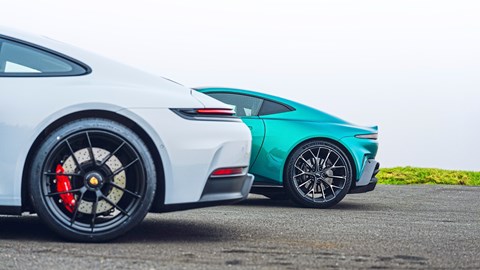
Gearshifts from the ZF auto transaxle come with a more rounded edge than the AMG’s multi-clutch transmission, but they’re still extremely quick and more refined when you’re pulling paddles at peak revs. They’re also positively buttery in normal driving. Combined with a final drive seven per cent shorter than before and tuned to be sharper than the somewhat apologetic original’s, the ’box marks another of many steps forward for the Vantage.
In fact, the transmission layout is key to another advantage the Aston holds over the Merc – weight distribution. Unlike AMG, Aston hasn’t concerned itself with providing lots of boot space or plus-two rear seats, which means that space can be taken up by the transaxle. So having the transmission nestled between the rear wheels and the V8 pushed so snugly back in the nose contributes to 50/50 weight distribution (and 235 litres of boot space to the Merc’s 321).
It takes very little time to sense the Aston has its mass better centred between the axles – it simply pivots around you in a more intuitive manner than the Merc does. The steering is a fixed ratio, but it’s natural and very quick to arc into a turn, keeping a clean, consistent sort of precision as it does so. The rear end then follows obediently and settles quickly, and even on just a breath of throttle to ease the Vantage into the curve, the e-diff already feels like it’s locking up ready for a bigger squeeze on the power and a bit of oppo if you fancy it – though traction is actually very good given the firepower on tap.
It’s a fantastically malleable car to hustle, plus there’s also brilliant multi-stage traction control to gradually allow more wheel slip so you can ease your way in.
The chink in the Aston’s armour when it comes to quick point-to-point progress is actually its ride. Mostly it leans to the firm side of pliant and does just fine but it cannot flow over the worst surfaces as dextrously as either the Porsche or the Merc. It nibbles more than both its rivals over the tricky secondary stuff and – more important when you start to really dig into the performance – has to work very hard to support its mass in compression over primary undulations that buck and heave. You start to get knocked about a bit and back off to calm it down.
But as an object to covet and a genuinely brilliant driver’s car for the vast majority of the time, the Aston’s most definitely in contention as we pull over to swap notes and choose our podium.
Verdict
It feels harsh to put in last position a car I enjoyed driving this much, but something has to come third, and in this case it’s the AMG. Every drive is quite an event, thanks to its agile chassis and brawny V8 engine – and a recent drive on track in the Pro version proved it to be both capable and highly engaging even in those extremes.
The Mercedes also has a useful boot and plus-two seats that make it better than the others for road trips, its all-wheel drive better harnesses performance in all conditions and its clever suspension is superior to the Aston’s as well as a match for the Porsche over tricky surfaces. Then again, it can’t string together corners as naturally as the others; it’s the heaviest, and feels it, and has least the feelsome and natural steering.

For many buyers, the Merc will tick more boxes than the Aston – but not for me. The Aston is the most beautiful car on test and now gets a vastly improved interior in keeping with its breeding. It also puts an even richer twist on the AMG’s brilliant V8, bringing genuinely incredible performance to the table, and handles with a more intuitive sort of flair – a benefit of its rear-wheel-drive layout and more evenly balanced weight distribution. Thanks to multi-stage traction control, you can also dip into the Aston’s exploitable handling without too much of a leap.
Its damping might not be able to cope with the very toughest surfaces as adeptly as the others, but mostly it rides just fine. It should definitely be taken very seriously indeed.
But it’s the way the 911 drives that really got under our skin, from its sublime ride to gorgeously detailed steering and the fluidity of its chassis – both within and beyond the limit of grip. Our sole complaint is road noise, which can become tiresome at a cruise.

All this could apply to any new Carrera, but the T-Hybrid system moves the needle with its huge slug of extra performance, instant throttle response and fuel-saving benefits, and all with only a 50kg penalty – yes, 12.3mpg in the heat of a road test is disappointing, but it’s better than the others, and a long motorway run suggests high 20s should be on the cards.
It’s a performance hybrid born not to game the test lab but to keep the 911 we know and love on the right side of emissions regulations.